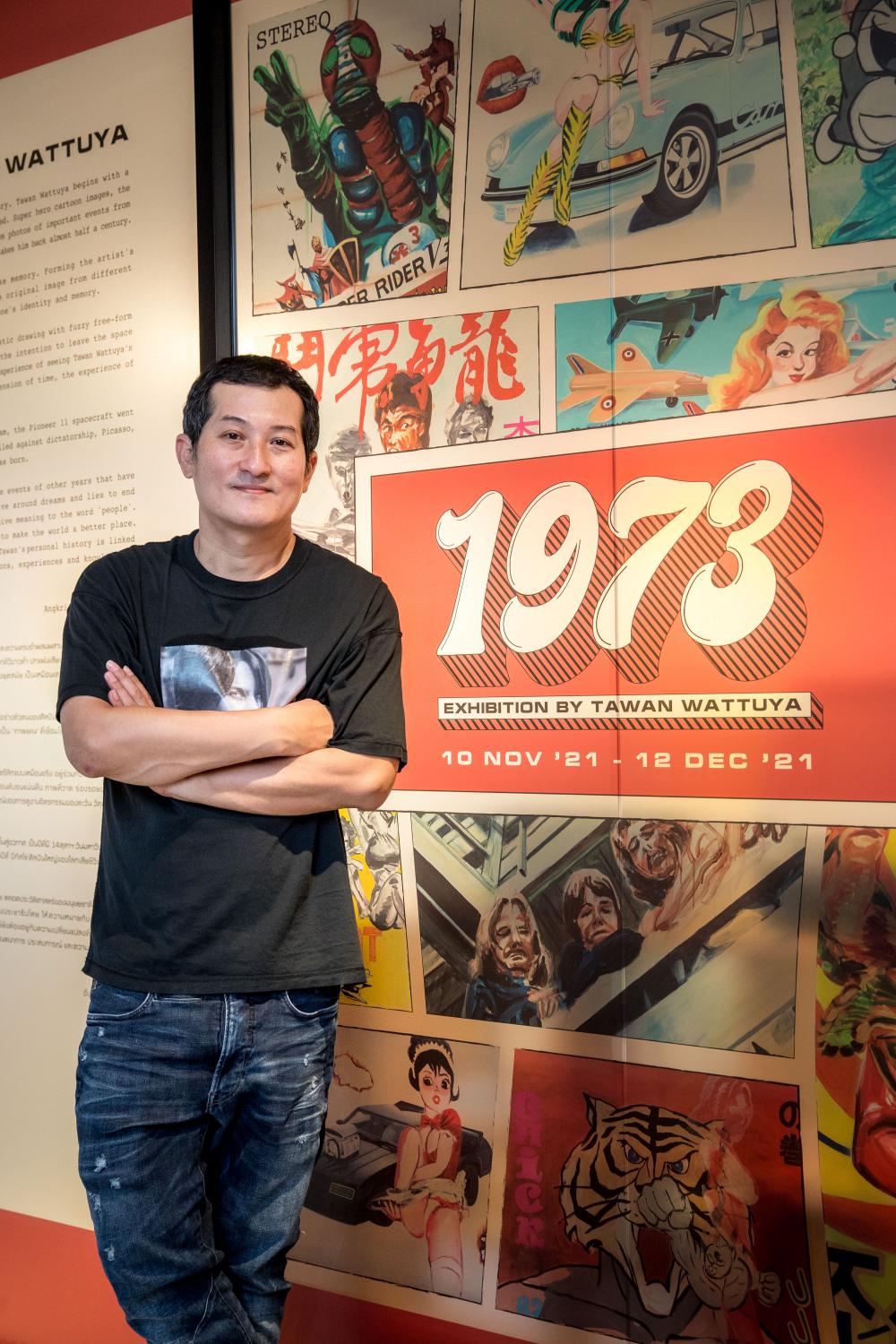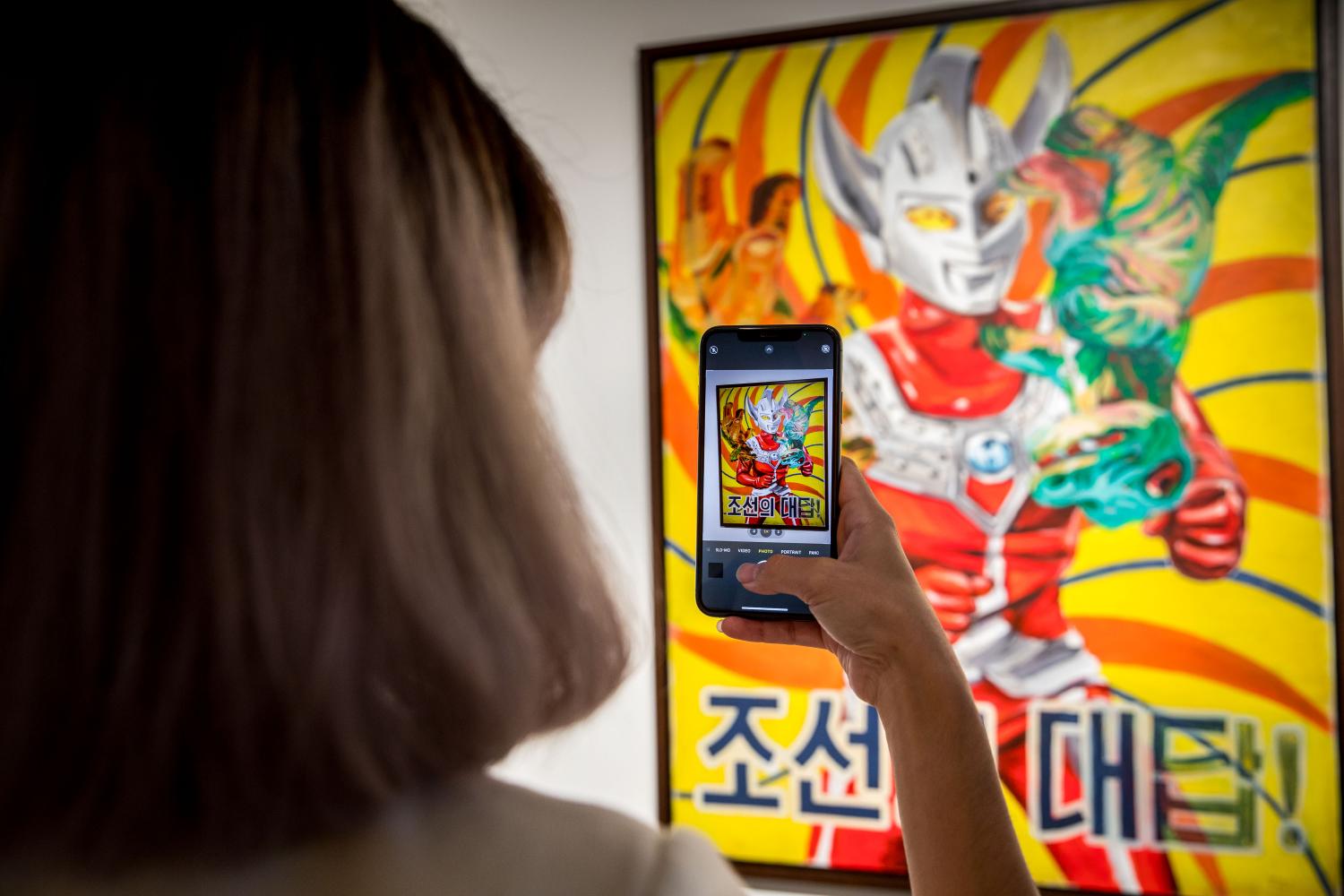Enter a realm of pop culture remembrances through the eyes of a 70s kid on the fourth floor of Central: The Original Store. Tawan Wattuya, the creator behind the art of memories, is an internationally-renowned watercolour painter known for his breakthrough exhibitions "500" and "Siamese Freaks".
His distinctive approach to watercolours in a series of satirical art and thought-provoking messages have captivated international eyes. This time, Tawan portrays pop culture from his memories in the "1973" exhibition, whose name is derived from his birth year. He gets out of his comfort zone, showcasing collage technique in a set of sentimental acrylic paintings. Tawan shares with Guru his background, the stories behind his exhibition and what it feels like to be raised in the good old days.

Was there a defining moment when you knew you wanted to become an artist?
Drawing has been my passion since I was a kid. However, I could not imagine myself growing up as a painter. I only dreamed of becoming a film director. If you take a closer look at my works in the exhibition, you will notice many characters and elements from old movies and cartoons, especially from Hollywood films and Japanese manga. Back then, pursuing my dream was quite impossible because we did not have any specific institute or programme for film directing. So, I enrolled in the Faculty of Arts at Silpakorn University.
I spent six years finishing my degree, which took more time than regular students. I dropped out of my fine art programme for almost a year to give my dream of becoming a film director a shot. I got a part-time job in an advertisement production team. However, spending time on a production set was a wake-up call for me and I realised that film directing is not my jam. I discovered that I do not enjoy working with a large group of people. So, I decided to go back to continue my studies.
Upon my return, I had to do a set of arts in order to return to the course and my thesis. That project was a life-or-death situation that would determine my future. I went to the countryside to immerse myself in painting for two weeks. After spending time by myself, I realised that I love drawing after all. Even though I have made some artwork in class before, those alone times have helped me discover my style and inner-painter spirit.

(Photos: Central: The Original Store)
Why did you choose to portray your childhood memories in '1973'?
Central: The Original Store is a place full of my childhood memories. Believe it or not, my parents met each other here because they both worked here. I remembered a younger version of me playing on the ground floor after school while waiting for them to finish their shifts. When I was visiting Central: The Original Store in preparation for my show, I saw many exhibitions on each floor exhibiting the quaint history of Central and the Charoen Krung neighbourhood. It triggered my deep, fond memories of spending time here. So, I decided to make something special about this place by portraying my dreams and childhood memories in the '1973' series.
We normally see the collage technique in scrapbooking. Why did you apply it to your painting?
I had the opportunity to make illustrated art using collage techniques for well-known lifestyle/fashion magazines like Image and Priew. When it comes to this exhibition, after I finished the main characters of each artwork, I was thinking about a creative way to add other details to those artworks. So, collage painting would be my go-to style to make this exhibition more creative and fun. Besides, collage painting also conveys my hidden message about the charm of art before the digital era. It portrays a technique that old-school artists used before every piece of collage art could be done by computer programmes. Back then, we could only make this type of art with a scissor and glue.
Why are some characters painted in black and white?
It portrays my childhood memories that every film and cartoon I watched on TV was in black and white. I did not have a colour television in the 70s.
Why do you think people today still look back on the charm of the analogue era?
The imperfection of analogue delivers its charm to people who have lived in the past and to the present. Songs played on a record player may not be as smooth as songs played on streaming or digital platforms, but their random hiccups during playback exude liveliness. It is like, why are people still going to concerts while we can watch them online? Some of us are captivated by the energy of life.
If you could travel to childhood, what year would be your destination? And why?
I would love to go back to the 70s, even though I was more of an 80s kid. Why? Back in the 80s, Thailand was seen as the coming era of technology, while the 70s, when I was born and raised, were filled with authentic culture. I'm not comparing which years are better. But the 70s were the years when we absorbed outside cultures pretty slowly, which meant we would have time to immerse ourselves in those cultures thoroughly. It is poles apart from the present day, where we are inundated with cultures and trends from all over the world. Some of us cannot even keep up with those transient cultures at all times.
I'm not surprised that famous artists from my generation have been brought back to life in the past few years. I think it was the pandemic that has slowed down the time for a new culture to grow. In the end, we will yearn for something that we are used to.
Bangkok is an ever-changing place. What places from childhood do you miss the most that are no longer there?
I have plenty of old places that I miss. If you want me to be more specific, the Scala Cinema would be my deepest sorrow. It crushed my heart to see another part of my memory had been torn down. Honestly, I have a bad feeling about Hua Lamphong Station, too. It might end up in a pile of dust like Scala someday. If that really happened, Bangkok would not be the same for me.
The "1973" exhibition by Tawan Wattuya is on display on the fourth floor of Central: The Original Store until Dec 12.

